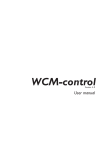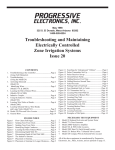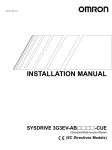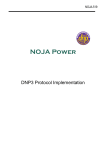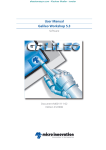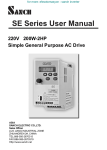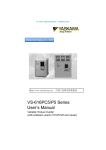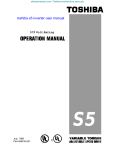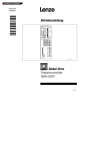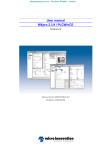Download Lenze DC speed controllers 530 series user manual
Transcript
Show/Hide Bookmarks EDB530_E/GB 00460234 efesotomasyon.com - Lenze L Operating Instructions Speed controllers 530 series efesotomasyon.com - Lenze Show/Hide Bookmarks These operating instructions are valid for controllers with the nameplate designation 531__ E . 532__ E . 533__ E . 534__ E . Controller type Chassis type Hardware version + index Edition of: 05/1996 revised: 12/2002 3A 3A 3A 3A Show/Hide Bookmarks efesotomasyon.com - Lenze How to use this manual ... To locate information on specific topics, simply refer to the table of contents at the beginning and to the index at the end of this manual. The manual uses a series of different symbols to provide quick reference and to highlight important items. This symbol refers to items of information intended to facilitate operation. Notes which should be observed to avoid possible damage to or destruction of equipment. Notes which should be observed to avoid health risks to the operating personnel. L 1 efesotomasyon.com - Lenze Show/Hide Bookmarks Safety and application notes for drive controllers (according to: Low Voltage Directive 73/23/EWG) 1. General During operation, drive controllers may have, according to their type of protection, live, bare, in some cases also movable or rotating parts as well as hot surfaces. Unauthorized removal of the required cover, inappropriate use, incorrect installation or operation, creates the risk of severe personal injury or damage to material assets. Further information can be obtained from the documentation. All operations concerning transport, installation, and commissioning as well as maintenance must be carried out by qualified, skilled personnel (IEC 364 and CENELEC HD 384 or DIN VDE 0100 and IEC report 664 or DIN VDE 0110 and national regulations for the prevention of accidents must be observed). Qualified skilled personnel according to this basic safety information are persons who are familiar with the erection, assembly, commissiong, and operation of the product and who have the qualifications necessary for their occupation. 2. Application as directed Drive controllers are components which are designed for installation into electrical systems or machinery. When installing into machines, commissioning of the drive controllers (i.e. the starting of operation as directed) is prohibited until it is proven that the machine corresponds to the regulations of the EC directive 89/392/EWG (Machinery Directive); EN 60204 must be observed. Commissioning (i.e. starting of operation as directed) is only allowed when there is compliance with the EMC Directive (89/336/EWG). The drive controllers meet the requirements of the Low Voltage Directive 73/23/EWG. The harmonized standards of the prEN 50178/ DIN VDE 0160 series together with EN 60439-1/DIN VDE 0660 part 500 and EN 60146/DIN VDE 0558 are applicable to drive controllers. The technical data and information about the connection conditions must be obtained from the nameplate and must be observed in all cases. 3. Transport, storage Notes for transport, storage and appropriate handling must be observed. Climatic conditions must be observed according to prEN 50178. 2 L Show/Hide Bookmarks efesotomasyon.com - Lenze 4. Erection The devices must erected and cooled according to the regulations of the corresponding documentation. The drive controllers must be protected from inappropriate loads. Particularly during transport and handling, components must not be bent and/or insulation distances must not be modified. Touching of electronic components and contacts must be avoided. Drive controllers contain electrostatically sensitive components which can easily be damaged by inappropriate handling. Electrical components must not be damaged or destroyed mechanically (health risks are possible!). 5. Electrical connection When working on live drive controllers the valid national regulations for the prevention of accidents (e.g. VBG 4) must be observed. The electrical installation must be carried out according to the appropriate regulations (e.g. cable cross-sections, fuses, PE connection). More detained information is included in the documentation. Notes concerning the installation in compliance with EMC - like screening, grounding, arrangement of filters and laying of cables - are included in the documentation of the drive controllers. These notes must also be observed in all cases for drive controllers with the CE mark. The compliance with the required limit values demanded by the EMC legislation is the responsibility of the manufacturer of the system or machine. 6. Operation Systems where drive controllers are installed must be equipped, if necessary, with additional monitoring and protective devices according to the valid safety regulations, e.g. law on technical tools, regulations for the prevention of accidents, etc. Modifications of the drive controllers and the operating software are prohibited. After disconnecting the drive controllers from the supply voltage live parts of the controller and power connections must not be touched immediately because of possibly charged capacitors. For this, observe the corresponding labels on the drive controllers. During operation, all covers and doors must be closed. 7. Maintenance and servicing The manufacturer´s documentation must be observed. This safety information must be preserved! The product specific safety and application notes in these operating instructions must also be observed! L 3 efesotomasyon.com - Lenze Show/Hide Bookmarks Contents 1 Features of the 530 series of controllers 5 2 Technical data 2.1 Controller-specific data 2.2 Dimensions 2.3 Scope of supply 2.4 Application as directed 6 6 7 8 8 3 Accessories 9 4 Installation 4.1 Installation 4.2 Connection 4.2.1 Installation corresponding to EMC 4.2.2 CE-typical drive system 4.3 Connecting voltage 4.4 Replacing the fuses 4.5 Connection diagram 13 13 13 16 17 20 21 22 5 Setting 5.1 Selection of the current range for type 534 5.2 Setting the current limit 5.3 Speed setting 24 24 25 25 6 Operating modes 6.1 Switching operation 6.1.1 Controller enable 6.1.2 Controller inhibit 6.2 Electrodynamic braking 6.3 Reversing 27 27 27 27 28 30 Index 4 31 L efesotomasyon.com - Lenze Show/Hide Bookmarks 1 Features of the 530 series of controllers The 530 series of controllers series comprises 4 half-controlled single-quadrant controllers with output powers from 0.36 kW to 2 kW for the operation of DC shunt or permanent magnet motors. • Compact single-board controllers for space-saving installation on a mounting plate or DIN rail 35 x 7.5 mm • Easy connection through screwless, vibration-proof plug and socket connectors • Protective cover prevents accidental contact of live components • Operation with tacho or armature voltage feedback with "I x R compensation" • Operational integrity even under mains voltage fluctuations and short-term mains failure because of static and dynamic voltage monitoring • Interference immunity from bad mains wave-form because of synchronizing filter and channel separation of the firing pulses • Compliance with the EC directive for the design of a CE-conform drive system l 5 efesotomasyon.com - Lenze Show/Hide Bookmarks 2 Technical data 2.1 Controller-specific data Controller Output power Mains frequency Mains voltage Armature current (can be changed for 534) Armature voltage for VL1, N = 230 V Field voltage Max. field current Perm. form factor I⋅R compensation Rated master voltagae Rated tacho voltage Acceleration time Min. speed Max. speed Ambient temperature during operation Set-value pot. type Fuse type Weight Chassis type E Operating instructions type 6 531 532 Pel [W] f [Hz] UL1, N [V] IAmax [A] 360 VA [V] 180 VF [V] IFmax [A] FFmax RA [Ω] 533 720 50...60 190...265 (100...132 with solder link) 2 4 8 12 180 180 170 0.6 1.4 0...10 1.6 0...5 0.9 x UL1,⋅N 0.3 1.4 0...20 VLN [V] 10 VTN [V] 10...120 Ti [s] nmin [nN] nmax [nN] Ta [°C] 1...10 0...0.25 0.75...1 0...45 m [kg] 534 1360 2040 1.5 1.2 0...2.5 10kΩ / 1W lin. ER00322194 FF6.3 / 250V FF8 / 250V FF20 / 250 V EFSFF0063ASA EFSFF0080A EFSFF0200A SA SB 0.4 1.2 33.531_E 33.532_E 33.533_E 33.534_E EDB0530/D/GB L efesotomasyon.com - Lenze Show/Hide Bookmarks 2.2 Dimensions Type 531 b c a 2) 1) d 1) 2) Jumper "BR1", "BR2" (change 230 V / 120 V) Jumper "BR3" (nmax setting) Type 531 a [mm] 35 b [mm] 160 Types 532 and 533 Im IxR ax a nmax Ti L 53 d [mm] 100 Type 534 Im IxR ax a c [mm] 150 nmax nm in Ti L 53 nmin 0 0 2) 2) g g ∅ 1) 1) ∅ c e f 1) 2) d b c b h e f d Jumper "BR1", "BR2" (change 230 V / 120 V) Jumper "BR3" (nmax setting) Type a [mm] b [mm] c [mm] d [mm] e [mm] f [mm] g [mm] h [mm] ∅ [mm] 532, 532 120 109 95 7 22.5 45 127 4.5 534 120 109 95 7 88 100 150 6 4.5 l 7 efesotomasyon.com - Lenze Show/Hide Bookmarks 2.3 Scope of supply The scope of supply includes: • the controller 53x_E • the operating instructions • the set-value potentiometer 10 kΩ • plug-in terminals 2.4 Application as directed • The controllers of the types 53x are electrical equipment for installation into control cabinets of electrical systems or machinery. • The controllers of the types 53x are designed as components for the control • • • • • 8 of speed-variable drives with separately-excited DC motors or for the assembly with other components to form a machine or system. Drive systems with drive controllers 53x which are installed according to the definition of a CE-typical drive system (see chapter 4.2.2), correspond to the EC EMC Directive and the standards mentioned below. CE-typical drive systems are - suitable for the operation on public and non-public mains and - provided for industrial applications. Because of the ground potential reference of the RFI filters, the CE-typical drive system which is described is not suitable for the connection to IT mains (mains without ground potential reference). The drive controllers are not domestic appliances, but they are designed for drive systems for commercial use. The controllers of the types 53x themselves are not machines according to the EC Machinery Directive. The final function is only determined when integrated into the machine construction of the user. The user must consider measures in his machine construction which limit the consequences in case of malfunction or failure of the drive controller (increase of the motor speed or sudden motor stop) so that hazards for persons or material assets cannot be caused, such as: − further independent equipment for the monitoring of safety-relevant variables (speed, travel, end positions, etc.) − electrical or non-electrical protective equipment (latching or mechanical blocking) − measures covering the complete system L efesotomasyon.com - Lenze Show/Hide Bookmarks 3 Accessories Type Armature choke Mains choke Type RFI filter Type Spring kit for DIN rail 15 mm Type Knob for pot. Type Scale for pot. Type Support for plugin boards Type Interference suppression module Typ Zinc-oxide varistor Type l 531 532 533 534 Suitable types depend on motor type 2.5 mH, 18 A − − ELN1_0250H018 − − − − EZF1_004A001 − EJ00329026 EZF1_01812A001 − EJ00329061 ER00308273 ER00308274 − EJ00304817 EZ00341588 S20 K275 307 957 B32 K275 308 935 9 efesotomasyon.com - Lenze Show/Hide Bookmarks Mains choke k e f m n c d a b Mains choke for L type 534 [mH ] ELN1_0250H018 2.5 10 I a b c d e f k m n Weigh [A] [mm [mm [mm [mm [mm [mm [mm [mm [mm t ] ] ] ] ] ] ] ] ] [kg] 18 96 77 84 61 96 87 90 5.5 9 2.4 L efesotomasyon.com - Lenze Show/Hide Bookmarks RFI filter (Vmax = 250 V ±0 %) Design A e f g b h d c a Design B e b d c f a Types Desi a b c d e f g h Fixing gn [mm [mm [mm [mm [mm [mm [mm [mm ] ] ] ] ] ] ] ] 531...53 EZF1_004A001 A 91.5 70 40 51 63.5 30 33 60.4 2 x M4 3 534 EZF1_018A001 B 116 85 39 108 50.8 100 4 x M6 l Filter [Type] 11 efesotomasyon.com - Lenze Show/Hide Bookmarks Armature choke k e f m Armature choke ELK_440H004 ELK_500H002 ELA_400H010 n c d a b L I [mH] [A] 40 4,4 50/15 2/10 40/12 10/18 a b c d e f k m n [mm] [mm] [mm] [mm] [mm] [mm] [mm] [mm] [mm] 104 82 84 66 100 92 100 5.8 11 120 100 90 84 107 103 115 5.8 11 150 122 121 101 130 132 140 7.0 13 The suitable type of armature choke depends on the motor type. 12 L efesotomasyon.com - Lenze Show/Hide Bookmarks 4 Installation 4.1 Installation The chassis-type controller is to be installed in a vertical position, with the terminals at the bottom, to ensure sufficient cooling and air circulation. The ambient temperature mut not exceed +45°C. Unwanted voltages fed back from the controllers to the supply mains are reduced by the connection of mains chokes and RFI filters. The components allocated to type 53x are listed in chapter 3 "Accessories". 4.2 Connection • The controllers contain electrostatically sensitive components. Prior to • assembly and servicing the personnel must be free of electrostatic charges. Discharging is possible by touching the PE fixing scew or another grounded metal part in the control cabinet. If you use residual current devices: − The controllers have an internal mains rectifier. After a short-circuit to frame a DC fault current may prevent the tripping of the residual current device. Therefore, take additional measures like zeroing or use universal current e.l.c.b. − Observe for the dimensioning of the release current of e.l.c.b. that capacitive compensating currents of the cable screens and RFI filters occuring during normal operation may cause false tripping. − Note for the use of universal e.l.c.b.: The preliminary standard prEN50178 (in the past VDE0160) about the use of universal e.l.c.b. has been decided by the German committee K226. The final decision about the use in compliance with the standard is made by the CENELEC/CS (European Committee for Electrotechnical Standardization) in Brussels. Further information on the use of universal current e.l.c.b. can be obtained from the supplier. l 13 efesotomasyon.com - Lenze Show/Hide Bookmarks • The plug connector is suitable for the connection of solid wire or single or multi-strand conductors of cross-sections between 0.14 and 2.5 mm². The length of the free wire should be between 8 and 9 mm. It is not necessary to use ferrules. 3 3 1 2 1 2 Before removing the protective cover, switch-off the controller and remove the connectors. Warning All controller terminals carry mains potential. It is therefore necessary that all input and output signals required for the control of the controller are, electrically, safely separated by measures outside the controller and have another protection against direct contact (double basic insulation). When using the supplied set-value potentiometer the mechanical fixing must have an additional PE connection and the connections must be insulated and covered. Prior to commissioning make sure that there is no earth fault in the connecting cables. The protective conductor must only be connected to the PE connection (6.3-mm spade connector). PE or ground connections to any other terminals cause a controller failure. Screen motor cables A, B, I and K as well as the control cables. The screen must be connected at both ends to the central PE connection. The control cables must not be longer than 10 m. Check the voltage rating of the screened cable. To ensure that the screening is effective, it should not be opened or interrupted. It should also be laid as close as possible at the cable ends. Connect the screening of the motor cables to PE in the motor terminal box. 14 L efesotomasyon.com - Lenze Show/Hide Bookmarks If the cable between RFI filter and controller is longer than 200 mm, use screened mains cables. The ground chassis connection should have as low a resistance and as large a surface as possible. Type 53x can be used for operation with armature voltage or tacho feedback (see chapter 4.5 "Connecting diagram"). In case of armature voltage control with "I x R compensation" insert a jumper between terminal 2 and terminal 4. Caution! At terminals 2/4 and 3/4 only the feedback system used must be connected. For master voltage operation remove the set-value potentiometer and apply the master voltage across terminal 7 (-) and terminal 8 (+). Caution! The master voltage must be free of mains and ground potential. Several controllers can only be operated from a master voltage when they are electrically isolated. Note for the connection of controller and motor Lenze controller Function Armature voltage Excitation voltage Armature voltage Excitation voltage Armature voltage DC tacho AC tacho with rectification l + + + + + + + - Motor (acc. to DIN 42017 / VDE 0530 part 8) Terminal Terminal other Motor type designations A 1B1 A1 DC motor uncompensated B 2B2 B2, A2 with commutating pole I F1 E1 winding K F2 E2 A 1C1 A1 DC motor compensated B C2 C2 with commutating pole I F1 E1 winding K F2 E2 A A1 Permanent magnet motor B A2 3 2A1 4 2A2 3 3A1 4 3A2 15 efesotomasyon.com - Lenze Show/Hide Bookmarks 4.2.1 Installation corresponding to EMC • Controllers cannot be operated on their own. The EMC of controllers on their • • • • • 16 own cannot be tested. Only the integration of the controllers into a drive system allows a test whether the objectives of the EC EMC Directive are met and whether the device are in compliance with the law about the electromagnetic compatibility of equipment. Lenze has done conformity tests with the controllers of the types 53x in certain, defined drive systems. These tested drive systems are called "CEtypical drive system" in the following. Therefore, the user of the controller has the choice, − either to determine the system components and their integration into a drive system himself and to determine the conformity under his own responsibility − or to install the drive system according to the CE-typical drive system as tested by the manufacturer of the controller and declared to be in compliance. If you observe the following measures you can assume that EMC problems caused by the drive system will not arise during the operation of the machine and the EMC Directive and the EMC law are satisfied. For any other installation, e.g. − use of unscreened cables, − use of collective RFI filters instead of the allocated RFI filters, − omission of mains chokes the machine or system must be tested whether it is compliance with the EC EMC Directive and the EMC limit values are considered. The compliance with the EMC Directive in the machine application is the responsibility of the user. L Show/Hide Bookmarks efesotomasyon.com - Lenze 4.2.2 CE-typical drive system Components of a CE-typical drive system System components Controller RFI filter Mains choke Armature and field cable Mains cable between RFI filter and mains choke and between mains choke and controller Control cables Motor Specification Controller of the types 531 to 534 Data and allocation see chapter 3 "Accessories" Data and allocation see chapter 3 "Accessories" Screened power cable with tinned E-CU braid with 85 % optical coverage. Tested maximum length: 50 m As from cable length of 200 mm: screened power cable with tinned E-CU braid with 85 % optical coverage. Screened signal cable type LIYCY DC motor with separate excitation Lenze series GFQ, GFR or similar Note: Controller, RFI filter, and mains choke are located on one mounting plate. Installation of the CE typical drive system The electromagnetic compatibility of a drive system depends on the type and accuracy of the installation. Take special care with − filters − screening − grounding Filters • Only use the RFI filters and mains chokes allocated to the controllers (see chapter 3 "Accessories"). − RFI filters reduce non-permissible high-frequency interferences to a permissible value. − Mains chokes reduce low-frequency interference which depends primarily on the motor cables and their length. For motor cables which are longer than 50 m additional measures are required. Screening • Screen all cables from and to the controller. • Make sure that motor cables are separated from signal and mains cables when laying the cables. • Avoid a common terminal board for mains input and motor output. • The cables must be laid as close as possible to the reference potential. Dangling cables are like antennas. l 17 efesotomasyon.com - Lenze Show/Hide Bookmarks Grounding • Ground all conductive metal components (controllers, RFI filters, mains chokes) by suitable cables from a central grounding point (PE bar). • Observe the minimum cross-sections prescribed in the safety information. However, for EMC the surface of the contact is important and not the crosssection. Assembly • Make a contact from controller, RFI filter, and mains chokes to the grounded • • mounting plate with as large a surface as possible. Zinc-coated mounting plates allow long-lasting contacts. For painted plates the paint of the mounting plates must be removed in all cases. If you use several mounting plates: − Make a conductive connection of the mounting plates with as large a surface as possible (e.g. using copper bands). Connect the screen of the armature and field cable to the mounting plate with as large a surface as possible: − Recommendation: Make the large-surface connection of the screens to the mounting plate with earthing clamps on bare metal mounting surfaces. • If there are contactors, motor protection switches, or terminals in the • • • 18 armature cable: − Contact of the screens of the connected cables to each other and to the mounting plate with as large a surface as possible. In the terminal box, connect the screen of the motor to PE: − Metal cable glands at the motor terminal box ensure a large-surface connection of the screen to the motor housing. If the total length of the mains cable between RFI filter and mains chokes and controller exceeds 200 mm: − Screen mains cables − Connect the screen of the mains cables to the mounting plate with as large a surface as possible. Connect the screen of the control cables to the mounting plate with as large a surface as possible. L efesotomasyon.com - Lenze Show/Hide Bookmarks Part of the CE-typical drive system which is located on the mounting plate L1 N Connection mains fuse RFI filter LINE Paint-free bare metal contact surface LOAD Mains choke 1) PE Paint-free surfaces for screen contact Controller L Mounting plate conductive connection with PE Screened field and armature cable PE Screened control cables PE bar PE connection Paint-free surface for screen contact 1) Connect screen of the motor cables at the motor side as well with a large surface to PE The mains choke is only necessary for type 534. l 19 efesotomasyon.com - Lenze Show/Hide Bookmarks 4.3 Connecting voltage As a standard, the controller is factory-set for the operation on a mains voltage from 190 to 265 V ±0 %. For a mains voltage from 100 to 132 V ±0 % replace jumper "BR1" with "BR2". Caution! This modification must only be carried out by qualified skilled personnel when no voltage is applied. After replacing the jumpers the protective cover must be reassembled. N BR2 BR1 7 T1-B T1-A 1 3 6 9 230V / 120V 5 T1-C 0,9VA EI 30 10 L 20 L efesotomasyon.com - Lenze Show/Hide Bookmarks 4.4 Replacing the fuses The fuses protect the controller from non-permissible operating conditions. After the operation of such a protective function, the controller and the system must be checked for further faults before replacing the fuses. For the replacement of the fuses remove the protective cover and disconnect the connectors. Caution! Removal of the protective cover and the replacement of the fuses must only be carried out by qualified skilled personnel when no voltage is applied. Defective fuses must only be replaced by the prescribed type (see chapter 2.1 "Controller-specific data"). The protective cover must be attached again after the fuses are replaced. l 21 efesotomasyon.com - Lenze Show/Hide Bookmarks 4.5 Connection diagram Type 531 1 L1 2) +VCC K A B 7 N I 2 8 9 16 17 3 4 2 PE A S G I Filter PE A K PE M L1 N 190...265V~ 50 / 60 Hz 1) (100...132 V~ 50 / 60 Hz) 1) 2) + B E n soll U TN = 10...120 V 3 RFR R=10 kΩ lin. 4 + G - 5 see chapter 4.3 "Connecting voltage" standard component Explanations ➀ ➁ ➂ ➃ ➄ Coded part Jumper "BR 3" Actual value tachogenerator Controller enable Master voltage Note: If the signals must be changed over via relays, use suitable relay contacts (e.g. gold-plated contacts). 22 L efesotomasyon.com - Lenze Show/Hide Bookmarks Types 532, 533, 534 2) 1 +VCC 2 3 4 7 8 9 16 17 L N 3) LK A A B I K PE 2 LD S + G 5 E n - soll R = 10 kΩ lin. U TN = 10...120 V RFR 3 A B I K Filter + M G PE - 4 U LN = 10 V PE L N 190...265V~ 50 / 60 Hz 1) (100...132 V~ 50 / 60 Hz) 1) 2) 3) see chapter 4.3 "Connecting voltage" standard component only required for type 534 Explanations ➀ ➁ ➂ ➃ ➄ Jumper "BR3" 6.3-mm spade connector Controller enable Master voltage Actual value tachogenerator Note: If the signals must be changed over via relays, use suitable relay contacts (e.g. gold-plated contacts). l 23 efesotomasyon.com - Lenze Show/Hide Bookmarks 5 Setting Turn trimmers "I x R", "nmax", "nmin", "Ti" and set-value potentiometer fully counterclockwise. Trimmer "Imax" is factory set to rated controller current. The current range selector for type 534 is factory set to 8 A. 5.1 Selection of the current range for type 534 The current range of type 534 can be set to 12 A by switching off the controller and moving selector S1 from position 8 A to position 12 A. Selector S1 12 A 8A Caution! The current range must only be set by qualified skilled personnel when no voltage is applied. 24 L efesotomasyon.com - Lenze Show/Hide Bookmarks 5.2 Setting the current limit Setting the current limit is only required if the maximum output current must be reduced. • Turn trimmer "Imax" fully counterclockwise and "nmin" fully clockwise. • Connect a moving coil ammeter into the armature circuit to measure the current. • Disconnect the field or stall the motor (observe the current capacity of the motor during standstill!). • For armature voltage control, remove jumper between terminals 2 and 4. • Connect mains, close switch "RFR". Turn "Imax" clockwise to set the armature current. • To calculate the value to be set, divide the rated armature current (see nameplate) by the form factor (IAN / FF). The permissible rated controller current must not be exceeded. • Then disconnect the mains, turn "nmin" fully counterclockwise, connect the field and for armature voltage control, reconnect the jumper between terminals 2 and 4. 5.3 Speed setting • For armature voltage control with "I x R compensation" insert jumper between terminals 2 and 4 as shown in the connecting diagram. • For speed control with tacho feedback remove jumper between terminals 2 and 4. Connect the tachogenerator (see connecting diagram). For rated tacho voltages > 40 V the setting range of the "nmax" trimmer can be improved by removing jumper "BR3" (see chapter 4.5 "Connecting diagram" and chapter 2.2 "Dimensions"). Caution! The jumper "BR3" must only be removed by qualified skilled personnel when no voltage is applied. In case of uncontrolled acceleration of the motor during speed setting, immediately open switch "RFR". In this case, either the tachogenerator feedback is missing or has incorrect polarity. l 25 efesotomasyon.com - Lenze Show/Hide Bookmarks After checking and correcting the wiring, commissioning can be started again. • Switch on the mains and close switch "RFR". Turn the set-value • • • 26 potentiometer to maximum or set the master voltage to VLN = 10 V. Turn trimmer "nmax" clockwise until the desired maximum motor speed is achieved. Turn set-value potentiometer fully counterclockwise or set master voltge to 0 V.Turn trimmer "nmin" clockwise until the desired minimum motor speed is achieved. If the minimum speed is to be zero, turn trimmer "nmin" counterclockwise until the motor has just stopped running in order to avoid dead movement of the set-value potentiometer in the low speed range. Check the setting of the maximum speed because nmin and nmax influence on each other. For armature voltage control with "I x R compensation" the motor speed loss under load is compensated by turning trimmer "I x R" clockwise. Set trimmer "I x R" at low speed until the minimum speed change between idle running and rated load is achieved. Then, check the setting at higher speed and the maximum speed setting. L efesotomasyon.com - Lenze Show/Hide Bookmarks 6 Operating modes 6.1 Switching operation 6.1.1 Controller enable If switch "RFR" is closed, the controller is enabled. If the switch "controller enable" (RFR) is open, the firing pulses are blocked and the controller is reset. 16 17 RFR Note: Only use low-current contacts for the switching of signal cables (20 V / 1 mA) 6.1.2 Controller inhibit The function "RSP", i.e.g the inhibiting of the controller with a normally-open contact is possible using the following connection. When "RSP" (controller inhibit) is closed, the firing pulses are blocked and the controller is reset. 7 16 17 RSP Note: Only use low-current contacts for the switching of signal cables (20 V / 1 mA) l 27 efesotomasyon.com - Lenze Show/Hide Bookmarks 6.2 Electrodynamic braking If the field is excited, the induced armature current is used for braking the motor. Before connecting the brake resistor, the controller is inhibited. The timer relay must be set such that the braking contactor only opens after the motor has stopped. Dimensioning of the brake resistor RB Neglecting the armature feedback for a required initial braking torque MBa, the initial braking current IABa results in: IABa = IAN ⋅ IAN MN MBa MBa MN = Rated armature current = Rated torque = Initial braking torque The braking resistor RB is calculated as follows: RB = UAa IABa ηA ηA = UA IA M n UAa ⋅ ηA 2 IABa = Armature voltage in the motor mode = Initial braking current = Armature efficiency 2π ⋅ M ⋅ n UA ⋅ IA = Armature voltage = Armature current = Torque = Speed The size of the brake resistor depends on the braking energy of the drive and the number of brakings. The braking current should not be more than twice the rated armature current and should not exceed the maximum starting current. 28 L efesotomasyon.com - Lenze Show/Hide Bookmarks To limit the switching voltage peaks, a zinc oxide varistor (RU) must be connected in parallel to the controller output. For long motor cables (> 50 m) or motors which are connected in parallel, it may be necessary to use an interference suppression module (see chapter 3 "Accessories") Braking circuit: 1) 2) Interference suppression module Mains choke is only required for type 534 Explanations K1, K2, K5 S1 S2 l Relay On Stop 29 efesotomasyon.com - Lenze Show/Hide Bookmarks 6.3 Reversing Reversing is obtained by changing the armature polarity. The motor is electrodynamically braked to standstill. The braking time must be set at the timer relay such that the motor is safely at standstill before the armature is reversed (for dimensioning of the brake resistor see chapter 6.2 "Electrodynamic braking"). To limit the switching voltage peaks, a zinc oxide varistor (RU) must be connected in parallel to the controller output. For long motor cables (> 50 m) or motors which are connected in parallel, it may be necessary to use an interference suppression module (see chapter 3 "Accessories") Reversing circuit: 1) 2) Interference suppression module Mains choke is only required for type 534 Explanations K5, K6, K7 S2 S3 30 Relay CW rotation CCW rotation L Show/Hide Bookmarks efesotomasyon.com - Lenze Index A R Accessories 9 Application as directed 8 Replacing the fuses 21 Reversing 30 B Braking Electrodynamic 28 C S Safety information 2 Scope of supply 8 Setting Select current range 24 Setting the current limit 25 Speed 25 Controller features 5 Controller-specific data 6 D Dimensions 7 Armature choke 12 Mains choke 10 RFI filter 11 E EC declaration of conformity CE-typical drive system 17 I Installation 13 Connecting diagram 22 Connecting voltage 20 Connection 13 Installation 13 O Operating modes 27 Controller enable 27 Controller inhibit 27 Electrodynamic braking 28 Reversing 30 l 31 efesotomasyon.com - Lenze Show/Hide Bookmarks 32 L



































